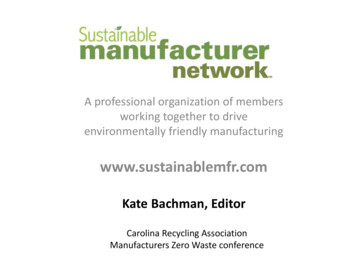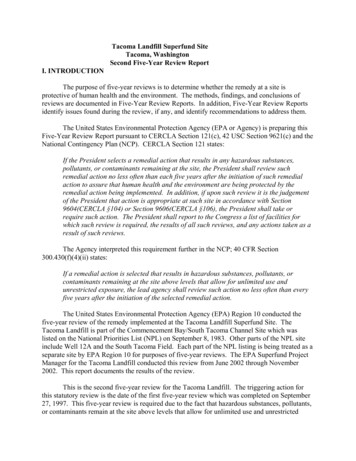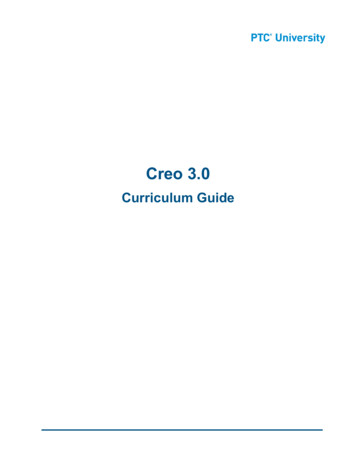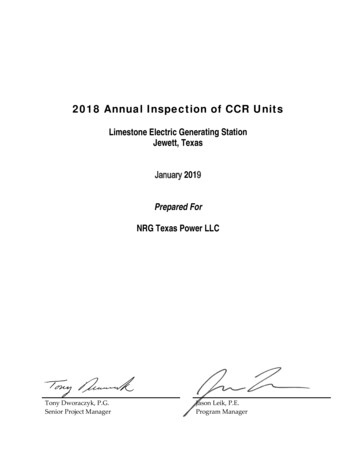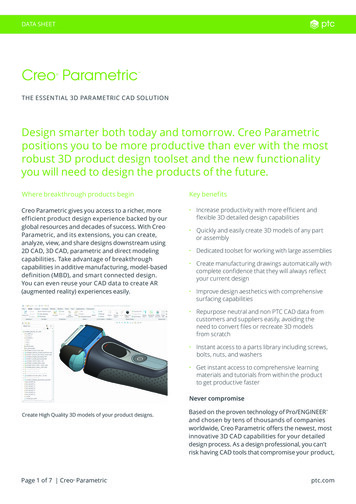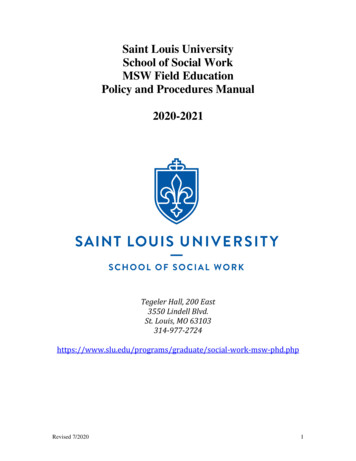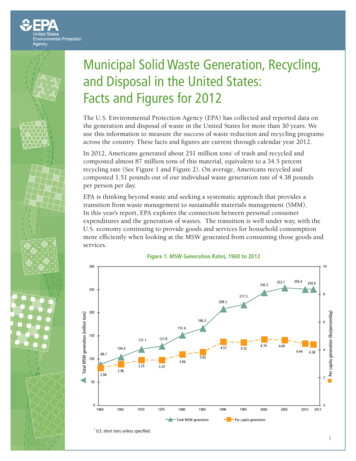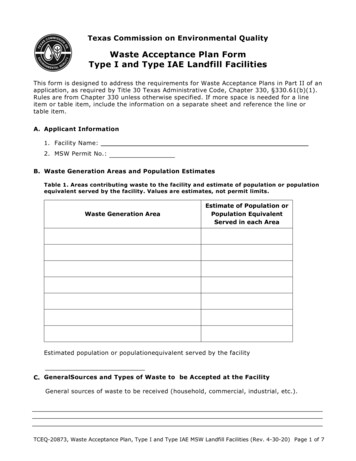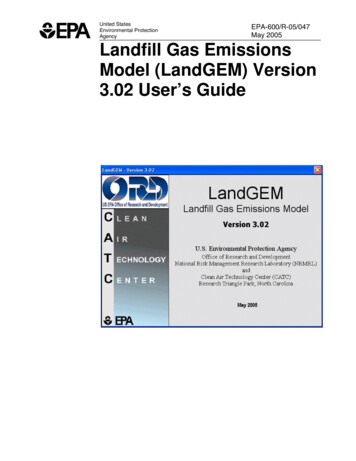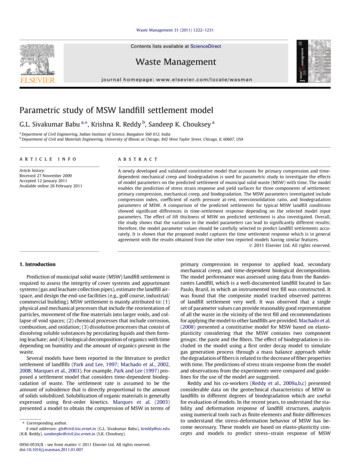
Transcription
Waste Management 31 (2011) 1222–1231Contents lists available at ScienceDirectWaste Managementjournal homepage: www.elsevier.com/locate/wasmanParametric study of MSW landfill settlement modelG.L. Sivakumar Babu a, , Krishna R. Reddy b, Sandeep K. Chouksey aabDepartment of Civil Engineering, Indian Institute of Science, Bangalore 560 012, IndiaDepartment of Civil and Materials Engineering, University of Illinois at Chicago, 842 West Taylor Street, Chicago, IL 60607, USAa r t i c l ei n f oArticle history:Received 27 November 2009Accepted 12 January 2011Available online 26 February 2011a b s t r a c tA newly developed and validated constitutive model that accounts for primary compression and timedependent mechanical creep and biodegradation is used for parametric study to investigate the effectsof model parameters on the predicted settlement of municipal solid waste (MSW) with time. The modelenables the prediction of stress strain response and yield surfaces for three components of settlement:primary compression, mechanical creep, and biodegradation. The MSW parameters investigated includecompression index, coefficient of earth pressure at-rest, overconsolidation ratio, and biodegradationparameters of MSW. A comparison of the predicted settlements for typical MSW landfill conditionsshowed significant differences in time-settlement response depending on the selected model inputparameters. The effect of lift thickness of MSW on predicted settlement is also investigated. Overall,the study shows that the variation in the model parameters can lead to significantly different results;therefore, the model parameter values should be carefully selected to predict landfill settlements accurately. It is shown that the proposed model captures the time settlement response which is in generalagreement with the results obtained from the other two reported models having similar features.Ó 2011 Elsevier Ltd. All rights reserved.1. IntroductionPrediction of municipal solid waste (MSW) landfill settlement isrequired to assess the integrity of cover systems and appurtenantsystems (gas and leachate collection pipes), estimate the landfill airspace, and design the end-use facilities (e.g., golf course, industrial/commercial building). MSW settlement is mainly attributed to: (1)physical and mechanical processes that include the reorientation ofparticles, movement of the fine materials into larger voids, and collapse of void spaces; (2) chemical processes that include corrosion,combustion, and oxidation; (3) dissolution processes that consist ofdissolving soluble substances by percolating liquids and then forming leachate; and (4) biological decomposition of organics with timedepending on humidity and the amount of organics present in thewaste.Several models have been reported in the literature to predictsettlement of landfills (Park and Lee, 1997; Machado et al., 2002,2008; Marques et al., 2003). For example, Park and Lee (1997) proposed a settlement model that considers time-dependent biodegradation of waste. The settlement rate is assumed to be theamount of subsidence that is directly proportional to the amountof solids solubilized. Solubilization of organic materials is generallyexpressed using first-order kinetics. Marques et al. (2003)presented a model to obtain the compression of MSW in terms of Corresponding author.E-mail addresses: gls@civil.iisc.ernet.in (G.L. Sivakumar Babu), kreddy@uic.edu(K.R. Reddy), sandeepkc@civil.iisc.ernet.in (S.K. Chouksey).0956-053X/ - see front matter Ó 2011 Elsevier Ltd. All rights reserved.doi:10.1016/j.wasman.2011.01.007primary compression in response to applied load, secondarymechanical creep, and time-dependent biological decomposition.The model performance was assessed using data from the Bandeirantes Landfill, which is a well-documented landfill located in SaoPaulo, Brazil, in which an instrumented test fill was constructed. Itwas found that the composite model tracked observed patternsof landfill settlement very well. It was observed that a singleset of parameter values can provide reasonably good representationof all the waste in the vicinity of the test fill and recommendationsfor applying the model to other landfills are provided. Machado et al.(2008) presented a constitutive model for MSW based on elastoplasticity considering that the MSW contains two componentgroups; the paste and the fibers. The effect of biodegradation is included in the model using a first order decay model to simulategas generation process through a mass balance approach whilethe degradation of fibers is related to the decrease of fiber propertieswith time. The predictions of stress strain response from the modeland observations from the experiments were compared and guidelines for the use of the model are suggested.Reddy and his co-workers (Reddy et al., 2009a,b,c) presentedconsiderable data on the geotechnical characteristics of MSW inlandfills in different degrees of biodegradation which are usefulfor evaluation of models. In the recent years, to understand the stability and deformation response of landfill structures, analysisusing numerical tools such as finite elements and finite differencesto understand the stress-deformation behavior of MSW has become necessary. These models are based on elasto-plasticity concepts and models to predict stress–strain response of MSW
1223G.L. Sivakumar Babu et al. / Waste Management 31 (2011) 1222–1231considering all processes contributing to the total settlement arerequired. Babu Sivakumar et al. (2010a) proposed a generalizedMSW landfill settlement model which accounts for the stress–strain characteristics through a constitutive model based on critical state concepts. The advantage of this model is that it is basedon the stress–strain (constitutive) response of MSW and it is a general model which can be applied to determine spatial variations insettlement depending on the landfill conditions. The model accounts for primary compression and time-dependent mechanicalcreep and biodegradation. The model is validated using the dataof Reddy et al. (2009a,b,c) from (a) fresh MSW obtained from working phase of a landfill, (b) landfilled waste retrieved from a landfillafter a year of degradation, and (c) synthetic MSW with controlledcomposition. The model captures the stress–strain and pore waterpressure response of these three types of MSW adequately. BabuSivakumar et al. (2010b) illustrated the applicability of the modelfor a typical MSW landfill. The predicted settlement results werecompared with the predicted settlement results obtained using14 different reported models. It is shown that the predicted settlements can vary significantly depending on the model used and theparameter values selected. Two of these reported models weredeveloped by Marques and his collaborators (Marques, 2001;Marques et al., 2003) which account for mechanical compression,mechanical creep and biodegradation similar to the constitutivemodel developed by Babu Sivakumar et al. (2010a,b). Marques(2001) model considers the mechanical compression based on consolidation theory and the mechanical creep and biodegradationthrough exponential decay functions. Marques et al. (2003) furtherdeveloped the model and termed it composite compressibilitymodel by considering the waste placement by a series of lifts. Allthese models require comprehensive geotechnical testing andanalysis as well as evaluation of geotechnical parameters for computation of time-settlement response.This paper first provides an overview of the models of Marques(2001) and Marques et al. (2003) and the constitutive model ofBabu Sivakumar et al. (2010a) and then highlights the need forparametric studies. Next, it investigates the general applicabilityof these models based on a systematic parametric study considering variations of different parameters for typical landfill conditions.Finally, the implications emerged from the parametric study arehighlighted.c secondary mechanical compression rate; Edg total compressiondue waste degradation; d secondary biological compression rate;t0 time elapsed since loading application; and t00 time sinceplacement of the waste in landfill.2.2. Modified Composite Rheological Model (Marques et al., 2003)Marques et al. (2003) further developed the model and termedit modified composite compressibility model that incorporatesthree mechanisms for one-dimensional compression of MSW viz.instantaneous response to load, mechanical creep, and biologicaldecomposition and also includes lift wise loading of MSW. Inimplementing the composite model, waste placement is idealizedas progressing in a series of lifts, as schematically illustrated inFig. 1. The thickness of the lifts may be set equal to the compactedthickness of the daily cells. After all lifts have been placed, the settlement DH, of the landfill surface at time, t, is determined.The total settlement is given by:DH ¼NXHi ½ePi þ eCi ðtÞ þ eBi ðtÞ ð3Þi¼1where N number of lifts in the landfill; Hi initial thickness ofcompacted lift i; ePi strain in lift i resulting from instantaneous response to loading from overlying lifts; eCi strain at time t in lift idue to mechanical creep associated with the stresses from theself-weight and the weight of overlying lifts; and eBi strain at timet in lift i due to biological decomposition of lift i. The strains are given by:ePi ¼C 0clog12Pci DHi þ Nj¼iþ1 Drij1c DH i2 i!ð4aÞ"#NX1 cðt t i Þ cðt t j ÞeCi ðtÞ ¼ b ci DHj ð1 eÞ þ tjDrij ð1 eÞ2j¼iþ1ð4bÞeBi ðtÞ ¼ Edg ð1 e dðt ti Þ Þð4cÞwhere ci is unit weight of lift i; Drij increment of vertical stressesimposed by lift j on lift i for j i; and t i and tj times at which lifts i2. Settlement predictive modelsThe total strain is given by:e ¼ eP þ eC þ eBð1ÞThe three terms, eP , eC , and eB represent strains resulting fromresponse to applied load, time-dependent strain due to mechanicalcreep, and time-dependent strain due to biological decomposition,respectively.2.1. Composite Rheological Model (Marques, 2001)Marques (2001) developed a composite rheological model to account for the primary and secondary compression and biodegradation mechanisms represented byDH¼ C 0c logH 00r0 þ Dr0þ Drbð1 e ct Þ þ Edg ð1 e dt Þr0ð2Þwhere DH settlement; H initial height of waste; C 0c ¼primary compression ratio; r0 existing overburden pressure acting at midlevel of the layer; Dr increment of overburden pressureacting at midlevel of the layer from the construction of an additional layer; b coefficient of secondary mechanical compression;Fig. 1. Waste placement process and composite model response (Marques et al.,2003).
1224G.L. Sivakumar Babu et al. / Waste Management 31 (2011) 1222–1231and j, respectively, were placed. The value of ci composite value representing the weighted average of the compacted waste and dailycover in lift i. Because t is a time after lifts of the landfill have beenplaced, t t i 0 and t t j 0 for values of i and j. If lift j is of greatlateral extent compared to depth of lift i, the value of Drij is equal tothe product of Hj and ci . Depending on the amount of informationavailable for a particular landfill under consideration, the parametervalues were adjusted to provide the best fit with the availabledata. This model has been validated with reference to fieldmeasurements.2.3. Proposed constitutive model (Babu Sivakumar et al., 2010a,b)Babu Sivakumar et al. (2010a) proposed a constitutive modelwhich can be used to determine settlement of MSW landfills. Inthis model, the elastic and plastic behavior as well as mechanicalcreep and biological decomposition are used to calculate the totalvolumetric strain of the MSW under loading as follows:dev ¼ deev þ depv þ decv þ debvð5Þpwhere deev , dev , decv , and debv are the increments of volumetric straindue elastic, plastic, time dependent mechanical creep, and biodegradation effects, respectively. The elastic volumetric strain deev canbe written as:edeev ¼ 0dej dp¼1 þ e 1 þ e p0ð6ÞAnd, increment in plastic volumetric strain can be written asdepv ¼# " 0k j dp2gdgþ1þep0M 2 þ g2Using Eqs. (6), (7), (10), and (11) and substituting in Eq. (5), totalincrement in strain is given by# " 0k j dp2gdgdev ¼þþ 2þ cbDr0 e ct dt1 þ e p01þep0M þ g2j dp0þ Edg e dt dt0A typical MSW landfill of 30 m height has been consideredwhich is assumed to be filled in ten layers each of 3 m deep asshown in Fig. 2. At the top of landfill, a final cover system has beenassumed to be constructed which consists of composite liner (compacted clay and geomembrane) overlain by a sand drainage layerand then a vegetative cover soil layer. This typical landfill situationis considered for estimation of time-settlement response using theproposed constitutive model (Babu Sivakumar et al., 2010a,b) aswell as using the models of Marques (2001), and Marques et al.(2003). In order to predict the settlement response of MSW underloading conditions using the constitutive model for different layers(from bottom to top), the following initial parameters are used forthe each layer: water content, specific gravity, coefficient of earthpressure at-rest (Ko), compression index and recompression index.The procedure for calculating settlement response for different layers using the constitutive model is as follows: For example, let usconsider P1 layer. Referring to Fig. 2,1. Calculate the initial void ratio e1 from the basic parameters.2. The MSW is considered as normally consolidated andOCR 1, K nco can be directly used from measurements or calculated using suitable expressions available in literature.3. Initially, when there is no fill and hence vertical and horizontal stresses are given by r0z1 ¼ cH and r0x1 ¼ r0z1 K nc0 .4. The stresses on the initial yield surface are given byð7Þ dt 00bev ¼ Edg ð1 eÞ0decv ¼ cbDp0 e ct dt0ð10ÞFrom Eq. (9), increment in volumetric strain due to biodegradation effect is written as:00debv ¼ Edg e dt dt00r0z1 ¼ cH5. The stress at the center of 1st layer is expressed asr0v ¼ðP10Þ c and r0h ¼ r0v K nc02.6. Stress increase is given byr0 þ 2r0hDp01 ¼ vand Dq ¼ ðr0v r0h Þ3ð9Þwhere Edg is the total amount of strain that can occur due tobiological decomposition; d is the rate constant for biologicaldecomposition; and t00 is the time since placement of the waste inthe landfill.From Eq. (8), increment in volumetric strain due to creep iswritten as:1 þ 2K nc0or0z1 & ðq0c Þ1 ¼ ð1 K nco Þrz1 ;3ðp0c Þ1 ¼ð8Þwhere b is the coefficient of mechanical creep; Dp0 is the change inmean effective stress, c is the rate constant for mechanical creep;and t 0 is the time since application of the stress increment. The biological degradation is a function of time and is related to the totalamount of strain that can occur due to biological decompositionand the rate of degradation. The time dependent biodegradationis given byð12Þ3. Calculation of settlement response for MSW usingconstitutive modelThe above formulations for increments in volumetric strain dueto elastic and plastic are well established in critical state soilmechanics literature (Wood, 1990).The mechanical creep is a time dependent phenomenon inexponential function given byecv ¼ bDp0 ð1 e ct Þ .7. The mean effective stress is expressed as:p01 ¼ ðp0c Þ1 þ Dp08. In the model, the pre-consolidation pressure is a timedependent function. It depends upon creep and biodegradation. The details are given in Babu Sivakumar et al. (2010a).From model, the pre-consolidation pressure is expressed as:p00" ¼DqMp01 2#k kjþ1expnhDp01ðe0 eÞþ bD1þe0iore ct þ Edg e dt ð1 þ eÞð11ÞIn the present case t0 time since application of the stress increment and t00 time since placement of the waste in the landfill areconsidered equal to ‘t’.It may be noted that the above equation also enables the calculation of pre-consolidation pressure if there is time lag byusing appropriate modifications in the second term in theexponential of the denominator.
1225G.L. Sivakumar Babu et al. / Waste Management 31 (2011) 1222–1231Fig. 2. MSW landfill scenario for estimation of settlement vs. time.Table 1Comparison of ultimate settlements using different models considering primary compression, mechanical creep and biodegradation.ModelPrimary compression (m)Primary compression creep (m)Primary compression biodegradation (m)Total settlement (m)Marques et al. (2003)Marques et al. (2003)Proposed .869. From the above calculated pre-consolidation pressure (p00 ),settlement response of P1 is expressed as:Ds ¼ 0 Hpk ln 001 þ e1p110. Similar calculations are performed for other layers. The loading due to nine additional lifts induces further settlements inthe first layer. The effect of the additional incremental loading is obtained using steps 6 and 7. Additional settlementdue to fill load is obtained as follows.11. Considering fill load, the overburden pressure at the centerof 1st layer is expressed asrv ¼ dP þðP1Þ c and rh ¼ rv K nc02.12. This settlement can be calculated based on equations insteps 8 and 9.13. Total settlement for the P1 can be obtained summing all thevalues of settlement.The landfilling is assumed to occur in a series of lifts of certainthickness (Hi) and the settlement in each thickness at a time is calculated assuming one-dimensional compression conditions(dev ¼ deHi ). Subsequently, the settlements in all the layers areadded to obtain the total settlement in the landfill.4. Evaluation of different components of MSW settlement usingdifferent modelsThe quantification of various components of overall MSW settlement is of primary interest in the analysis of the long-term compressibility analysis of landfills. Table 1 presents the componentsof settlements in terms of (i) settlement due to primary compression only, (ii) settlement due to primary compression and mechanical creep, (iii) settlement due to primary compression andbiodegradation effect, and (iv) settlement due to primary compression, mechanical creep and biodegradation effect computed usingthe proposed model. It can be noted that the primary compressionconstitutes 63.7%, creep contributes to additional 8.2% and the biodegradation contributes to 28.1% for the ultimate settlement basedon the model of Marques (2001). Model of Marques et al. (2003)gives settlement components in which primary compressionconstitutes 63.2%, creep contributes to additional 9.6% andthe biodegradation contributes to 27.2%. The proposed model givescontributions to the ultimate settlement in the range of 65% forprimary compression, 9% for creep and 26% for biodegradation.Hence, though the values of ultimate settlement are in the samerange, the contributions of each component are marginally different. The proposed model gives higher creep settlements due tomechanical creep and lower values for settlement due to biodegradation for the set of data considered. Thus the observed values ofsettlement are in the similar range and comparable to the
1226G.L. Sivakumar Babu et al. / Waste Management 31 (2011) 1222–1231predicted values from the model of Marques et al. (2003) whichhas been validated with reference to field studies. Further, the proposed model has the advantage of obtaining stress strain responseof the MSW due to the three mechanisms separately as well as collectively as shown in Fig. 3 for the set of parameters presented inTable 2. Fig. 3 shows the stress strain response due to three components separately as well as collectively. It is also possible to obtain yield surfaces for different times that correspond to totalsettlement as shown in Fig. 4. These two aspects are unique features of the proposed model presented herein.300Primary compressionPrimary compression creepPrimary compression biodegradationDeviatoric stress (kPa)Primary compression creep biodegradation200100003691215Strain (%)Fig. 3. Stress–strain response considering different mechanism using the proposedmodel.Table 2Parameter values used to obtain stress–strain response of MSW.ParameterValuesCompression index, kSwelling index, jInitial void ratio e0Friction angle, u0Over-consolidation ratio, OCRSpecific gravity, GRate constant for mechanical creep, cCoefficient of mechanical creep, b0.17340.00430.42682010.970.001790 day 10.000572 m2/kN0.1500.001140 day 1Total amount of strain due to biological decomposition, EdgRate constant for biological decomposition, d5. Need for parametric studyThe settlement predictive models involve many parameters related to compressibility and biodegradation which vary widely. Forexample, Machado et al. (2008) showed that biodegradation ismodeled in terms of strength and stiffness of fibers that are biodegradable. Literature review indicates that the influence of theparameters related to (i) compressibility (C c ), (ii) coefficient ofearth pressure at-rest (Ko), (iii) overconsolidation ratio (OCR), (iv)total biodegradable strain (Edg ), and (v) biodegradation rate constant (d) on the settlement response is significant.Compressibility of waste is important from the integrity viewpoint of the landfill structure. Waste compresses due to increasein effective stress (primary compressibility) and due to mass lossfrom biodegradation (secondary compressibility). The compressibility of waste was first studied by Sowers (1973) and he reportedthat the compression index (Cc) is related to the initial void ratio(eo) and can vary between 0.15 eo and 0.55 eo. The upper limit corresponds to MSW containing large quantities of food waste andhigh decomposable materials. The value of secondary compressionindex (Ca) varied between 0.03 eo and 0.09 eo. Results of Gabr andValero (1995) showed consolidation tests that yielded Cc varyingfrom 0.4 to 0.9, and Ca varying from 0.03 to 0.009 for the initialvoid ratios (eo) in the range of approximately 1.0–3.0. Machadoet al. (2002) obtained the values of primary compression indexwhich varied between 0.52 and 0.92. It is lower for lower MSWvoid ratios, which confirms the interdependence of Cc and e.With increased use of bioreactor landfills which involves leachate recirculation to enhance biodegradation in contrast to traditional dry landfills, there is a need to study the effect ofbiodegradation on time-settlement response. Bareither et al.(2010) showed that the rate of time-dependent waste settlementattributed to biodegradation is about 1.6 times larger in bioreactorlandfills than in conventional landfills, and increases as the recirculation dosage increases. The time dependent strain due to biodegradation is expressed by equation which uses Edg , the parameterrelated to total amount of strain that can occur due to biodegradation and d is the rate constant for biological decomposition. Thisapproach was proposed by Park and Lee (1997) to correlate biological degradation and the associated secondary settlements with thesolubilization rate of degradable matter in solid waste. The totalbiodegradable strain Edg depends on the total biodegradable material present which can vary from very low values (less than 1%) tovalues as high as 25%. For example, Marques et al. (2003) reportedTime (days)1350700 days21000 days250100010000Cc 0.30Cc 0.40Cc 0.50Cc 0.604Settlement (m)q (kPa)10001 day30010200150100681050120010020030040014p' (kPa)Fig. 4. Yield surfaces for different times using the proposed model.Fig. 5. Time vs. settlement response of MSW for different values of compressionindex (C c ).
1227G.L. Sivakumar Babu et al. / Waste Management 31 (2011) 1222–1231the values of total biodegradable strain varying from 0.214 to 0.131with an average value of 0.159. Barlaz et al. (2010) analyzed theperformance of different types of landfills in terms of chemicaland biological characteristics and showed that bioreactor landfillssupported accelerated methane generation at several landfills.The gas generation was in the range of 0.08–0.21 year 1 relativeto the default decay rate of 0.04 year 1. The rate constant in thebiological decomposition is expressed by the rate of biodegradation (d) and Marques et al. (2003) reported an average value of0.0114 day 1 for this parameter.It may be stated that while the qualitative influence of theseparameters on settlement of MSW is known, it is essential to obtain the values in quantitative terms in terms of time-settlementbehavior for different parameters and this is possible by conducting parametric studies using suitable models discussed earlierand consider all the above factors.6. Parametric studyThe objective of this study is to examine the results of variationof landfill settlement with time considering the variations of different ranges of parameters over 30 years (10,950 days, which is typically the landfill closure time specified) and draw inferences withregard to time-settlement response of MSW.21Settlement (m)18Table 3Effect of compression index on maximum MSW settlement (m) using differentmodels (u ¼ 20 , Edg ¼ 0:150, d 0.00011 day 1 (0.04 year 1)).Ko151296Compressionindex (C c )Marques(2001)Marques et al.(2003)Proposed h pressure at rest (Ko)Fig. 7. Variation of earth pressure (Ko) with settlement keeping (OCR 1) constant.abTime (days)1101001000Time (days)1000010101001000100000Marques 2001Marques et al. 2003Proposed modelCc 0.30Cc 0.4Marques 2001Marques et al. 2003Proposed modelSettlement (m)Settlement (m)2436689cTime (days)110100Time (days)d100010000110100Cc 0.5Cc 0.6Marques 2001Marques et al. 2003Proposed model3Settlement (m)Settlement (m)36699121210000015Fig. 6. Influence of compression index (Cc) on time settlement response.Marques 2001Marques et al. 2003Proposed model10000
1228G.L. Sivakumar Babu et al. / Waste Management 31 (2011) 1222–123187.9OCRSettlement (m)7.87.77.67.57.47.37.27.121.510.5OCRFig. 8. Variation of OCR with settlement keeping (Ko 0.6) constant.6.2. Influence of earth pressure at-rest (Ko)6.1. Influence of compression index (Cc)Using the proposed model, for different values of compressionindex from 0.30 to 0.60, time-settlement response is predictedkeeping the other parameters constant. Fig. 5 shows the settlementresponse for the different values of compression index. Comparison of values of maximum settlement from all the three modelsaTime (days)0110100Edg 0.071000and the model parameters used are given in Table 3. Fig. 6(a)–(d)shows the comparison of time-settlement response for the different models for various values of compression index. It can be notedthat the higher values of compression index are associated withlarger settlements.It can also be noted that there is a good agreement between thepredictions of the constitutive model and those from the modelsproposed by Marques (2001) and Marques et al. (2003). Thereare minor differences in the settlement at the initial stage, butthe ultimate settlement at the end of 30 years (10950 days) is veryclose. This observation lends support to the use of newly developedconstitutive model as well as the models of Marques and co-workers in the prediction of settlement of MSW. The general observation from all three models is that with increasing values ofcompression index, the predicted value of ultimate settlement ismore.10000Earth pressure coefficient (Ko) is one of the important parameters which influences the engineering response of MSW. Severalresearchers presented various ranges of values of coefficient ofearth pressure at-rest in a highly scattered form. For example, Dixon et al. (1999) estimated in situ Ko values for 1–3 years old MSWand 11 years old MSW using a self-boring pressure meter. The Kovalues in this case are estimated by moderate strains induced bythe pressure meter test and gave typical ranges of Ko from 0.16bTime (days)01Marques 200110100Settlement (m)Settlement (m)Proposed model69c369Time (days)110100100010000dTime (days)110100Edg 0.15Edg 0.18Marques 2001Marques et al. 2003Proposed modelSettlement (m)Settlement (m)36699100000310000Marques 2001Marques et al. 2003Proposed modelEdg 0.12Marques et al. 20033100012Fig. 9. Comparison of total biodegradation strain (Edg) with different models.Marques 2001Marques et al. 2003Proposed model10000
1229G.L. Sivakumar Babu et al. / Waste Management 31 (2011) 1222–1231Table 4Effect of total biodegradation strain on maximum MSW settlement (m) usingdifferent models (u ¼ 20 , Cc 0.40, d 0.00011 day 1 (0.04 year 1)).results, it is concluded that the with increase in earth pressureat-rest (Ko) settlement is reduced.Total biodegradationstrain (Edg )Marques(2001)Marques et al.(2003)Proposedconstitutive model6.3. Influence of overconsolidation ratio .138.697.497.868.178.74Generally, it is assumed that the MSW is normally consolidatedwith OCR 1. In order to investigate the effects of increased OCR,settlement was computed assuming different values of OCR ranging from 1.0 to 2.0. Fig. 8 shows the variation of settlement withrespect to different values of OCR. From Fig. 8 it is observed thatthe settlement decreases with increase in OCR. The results indicatethat for OCR 1, the ultimate settlement was estimated as 7.93 m,whereas for OCR 1.8 the ultimate settlement was decreased to7.15 m.to 0.85. Landva et al. (2000) conducted a series of large-scale onedimensional compression tests with measurements of lateral stresses and estimated Ko for five reconstituted specimens of MSW,with fiber different compositions. Ko values reported for the fivespecimens were 0.4, 0.35, 0.33, 0.34, and 0.26, with the results suggesting that the Ko value reduces from 0.4 to 0.23 as the fiber content increases.In the present study, different values of earth pressure at-rest(Ko) have been used in the calculation of MSW settlement usingthe proposed model, while keeping the all other parameters thesame. Fig. 7 shows the variation of settlement with earth pressureat-rest (Ko). It should be noted that MSW is assumed normally consolidated in calculating the settlement; in ot
Parametric study of MSW landfill settlement model G.L. Sivakumar Babua, , Krishna R. Reddyb, Sandeep K. Choukseya a Department of Civil Engineering, Indian Institute of Science, Bangalore 560 012, India bDepartment of Civil and Materials Engineering, University of Illinois at Chicago, 842 West Taylor Street, Chicago, IL 60607, USA article info Article history:
